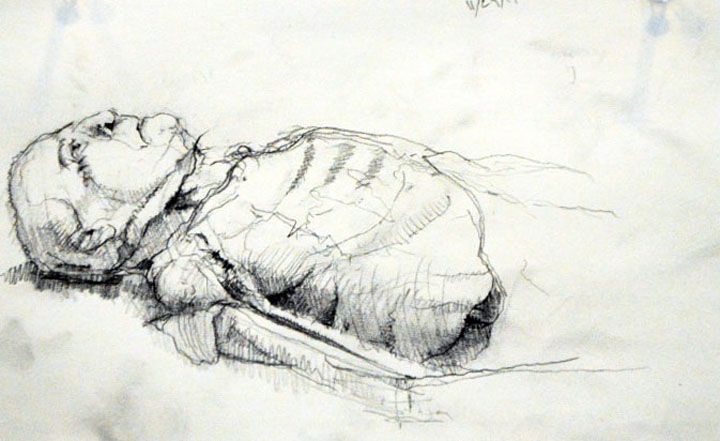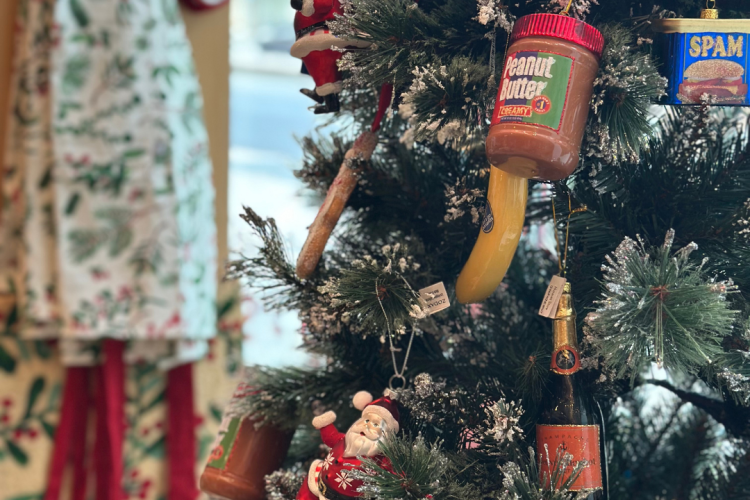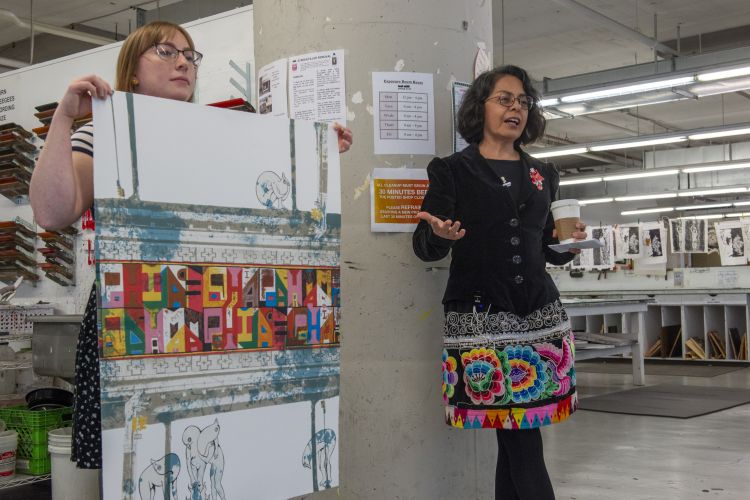STORIES FROM PAFA
Cadaver Drawing Lets Students Train Like the Old Masters
“Back in the day the masters did this but didn’t have permission,” said Neill Catangay (MFA ’20) as he stands over a cadaver in a lab at Hahnemann University Hospital. “This is intentional, we’re not breaking into the morgue and drawing.”
Catangay and several of his PAFA classmates meet at Hahnemann throughout the semester for anatomy drawing sessions. The outing is not an official class but is open to all PAFA students. Participants, overseen by PAFA professor Anthony Ciambella, have the opportunity to study the human figure inside and out.
“As artists, we’re always interested in the figure,” Catangay said. “My work more reflects the internal body and what better way to study than to get into a hospital with an anatomy class where you get to see the inside of the body.”
Students draw cadavers that have been donated. The donated remains give medical students an opportunity to learn and practice their skills.
“Within five minutes of getting in there it’s dead silence for an hour and a half, the students are busy drawing,” Ciambella said. “It’s like drawing a cast, not to make a pun but it's still life. The students just draw, sometimes we’ll have six people around a table and they won’t say a word to each other and they’ll just draw.”
As the semester goes on, medical students work to open the cadavers, allowing PAFA students a better view into the human body.
“The medical students dissect these, they really open them up and you see everything,” said Katie Weidlein (MFA ’19). “Last semester there was one where the skull was sawed vertically down the whole head so you could see inside the sinuses and stuff.”
This is Weidlein’s third semester participating in the anatomy classes. She was looking to practice her drawing skills in a low-pressure environment and wanted to learn anatomy like the masters did.
“They would learn anatomy and then they’d draw better because they knew how the body worked,” she said. “I thought coming to the source would be a better option than just making things up or reading a book about anatomy. This is real.”
Students are given basic information about each cadaver, age, and cause of death. Weidlein often chooses which cadaver to draw based on the cause of death. She once drew a woman who died of breast cancer because of a family connection.
“My grandma died of breast cancer so I felt like it made me feel oddly connected to her,” she said. “I know this is kind of weird but I don’t know, it made me feel like I could know her.”
Unlike the work she makes in her MFA classes, Weidlein keeps her cadaver drawings mostly to herself. She shares the occasional drawing on Instagram but says this work is just for her.
PAFA professor Anthony Ciambella said the artists incorporate the experience into their work in many different ways. He has used anatomy as a jumping off point to create landscapes and abstracts.
“Some people do academic renderings that look just like what you’re seeing and some people are more interpretive, they take it to another space and place,” he said.
Rachel Falzon, a first-year MFA and new to the anatomy classes, said she was drawn to PAFA in part because of the cadaver drawing course. Her work is a mixture of figure representation and abstraction.
Going to the anatomy lab was an intense experience for her. Falzon had never seen a dead body before the orientation.
“I have very little experience with death and there were bodies that had been worked on a lot. There was this feeling of you have to detach yourself from the fact that it's a body but also like you’re facing it right in the face,” she said. “It satisfies that morbid curiosity but at the same time it’s super disturbing.”
Even though it’s an extreme experience, Ciambella said this first-hand study of muscle groups and the human form is invaluable to a student's art practice and could lead to a new career.
Each year selections from the Anatomy Drawing Program are put on view at PAFA and several program participants have gone on to become medical illustrators.
“Every student seems to get something different from the experience.”
We're so excited you're planning to visit PAFA!
Make time for art — visit us Thursday to Sunday.
Before reserving your tickets, please review helpful information about museum hours, accessibility, building access, and special admission programs.
If you have any questions, feel free to reach out to us at visitorservices@pafa.org — we’d love to help!




